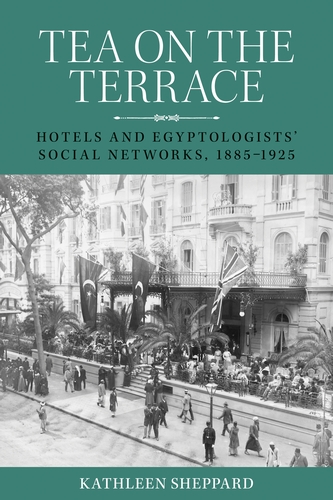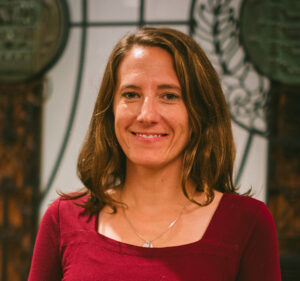In new book, S&T historian explores archaeologists' and Egyptologists' social networks
Posted by Andrew Careaga

When most of us think of social networks, we think of connecting digitally with others through sites like Facebook, TikTok or Twitter. A new book by Dr. Kathleen Sheppard, an associate professor of history at Missouri University of Science and Technology, discusses a different type of social network – a physical network of archaeologists, Egyptologists, tourists and other travelers who were drawn to Egypt in the late 19th and early 20th centuries.
In Tea on the Terrace: Hotels and Egyptologists' social networks, 1885-1925, Sheppard examines how "small, ephemeral communities" emerged among travelers to Egypt during the height of exploration of its pyramids and ruins. For archaeologists, Egyptologists, tourists and other travelers of this era, the European-style hotels of Alexandria, Cairo and Luxor served as places to gather after long days at dig sites. These travelers would mix and mingle informally in hotel dining rooms and ballrooms to exchange knowledge, debate ideas and even find work on an archaeological dig. Sheppard says these social interactions formed an overlooked yet integral part of the process of disseminating the knowledge unearthed by archaeologists and their crews.
"Egyptian hotels represent an important locus for the creation of archaeological knowledge and the networks necessary for that knowledge," Sheppard writes in the introduction to Tea on the Terrace. The book, published by Manchester University Press, will be released Tuesday, Aug. 2.
"The work Egyptologists did in the social spaces of hotels reveals more about how scientific inquiry is done in the field: it has never been all about the trowel, the artefacts, or the subsequent reports," writes Sheppard, who also holds the Lawrence O. Christensen Endowed Faculty Fellowship at Missouri S&T. "Egyptology is social; participation is decided in the spaces in which power is exercised."
The book's title refers to a common ritual among these hotel denizens. "Egyptologists and archaeologists met on the terrace for tea, in ballrooms during dances, in dining rooms for meals, and in their private rooms, all to discuss scientific matters," Sheppard writes. "In doing so, they turned hotels into scientific institutions."
In Tea on the Terrace, Sheppard takes readers on a journey up the Nile River, from the city of Alexandria on the northern coast of Egypt – the starting point for most travelers – to Cairo and Luxor, where the famous archaeological sites are located.

At Cairo, archaeologists and tourists of that era would venture to the Giza pyramid complex or the ancient cities of Memphis and Heliopolis. At Luxor – once the ancient Egyptian city of Thebes – visitors would cross the Nile to explore the temples and tombs of the Theban Necropolis, the Valley of the Kings and the Valley of the Queens. The Valley of the Kings is where Egyptologist Howard Carter found King Tutankhamun's tomb in 1922.
Sheppard draws on a broad array of archival materials, including the diaries and journals of archaeologists, Egyptologists and other travelers, to illustrate how their hotel encounters influenced their research, led to long-lasting friendships and, for some, provided opportunities for work. For example, one budding Egyptologist, E. Harold Jones, who traveled from England in hopes the dry climate would heal his tuberculosis, "took advantage of the wide network of Egyptologists staying in hotels all over Luxor and Cairo in order to find a new job," Sheppard writes.
Sheppard's book includes numerous vignettes about the famous and not-so-famous characters on the scene in Egypt during that 40-year period. "I'm a biographer at heart," she says, "so I wanted to tell their stories."
Many of the characters are familiar to those familiar with Egyptology. They include Carter, who found King Tutankhamun's tomb, and James Henry Breasted, who was "a wet-behind-the-ears Ph.D." – and the first American to earn a Ph.D. in Egyptology – when he first traveled to Egypt in the late 1800s but was a leading Egyptologist by the time he returned in the 1920s to support Carter.
Sheppard also discusses the mostly overlooked role of women in the discipline. For example, Emma Andrews, a partner and companion of self-taught archaeologist and patron Theodore Davis, was just as wealthy as the millionaire Davis and was financing excavations on her own.
"If a man were doing this, that would not have been surprising," Sheppard says. "But for a woman to pay for the cost of excavating a site was unexpected. The roles of women in the field at the time were often the same as men. We just didn't hear about them."
The 40-year period from 1885 through 1925 represents the height of exploration of the Egyptian ruins, as well as a rise in interest among archaeological tourists, Sheppard says. The era coincides with the British conquest of Egypt in 1882 and its subsequent occupation of the land as a British protectorate until 1922, although the British presence in Egypt continued into the 1950s.
The timing of Sheppard's book coincides with many important anniversaries related to Egypt's history: Carter's discovery of King Tutankhamun's tomb 100 years ago, the 140th anniversary of the founding of the Egyptian Exploration Society, the 140th anniversary of the British bombardment of Alexandria, and the 200th anniversary of decipherment of Egyptian hieroglyphics.
Sheppard began teaching at Missouri S&T in fall 2011 following two years teaching at American University in Cairo, where she first became interested in the relationship between hotels and archaeologists. But her interest in Egyptology began much earlier.
"When I was 9 years old my dad showed me a copy of a 1979 National Geographic that had King Tutankhamun's mask on the cover," she says. "I was more interested in Howard Carter and what he was doing" than about the boy king. "But as I looked at this magazine I also wondered, 'Where are the girls?'"
Sheppard's previous books include The Life of Margaret Alice Murray: A Woman's Work in Archaeology, published in 2013, and My Dear Miss Ransom: Letters between Caroline Ransom Williams and James Henry Breasted, published in 2018.
Sheppard earned her Ph.D. and Master of Arts degrees in the history of science from the University of Oklahoma. She also holds a Master of Arts degree in Egyptian archaeology from University College, London, and a Bachelor of Arts degree in anthropology and sociology from Truman State University.
In addition to Egyptology, Sheppard also conducts research on women in the history of science. This fall, she will teach History of Medieval and Early Modern Science at Missouri S&T.
About Missouri University of Science and Technology
Missouri University of Science and Technology (Missouri S&T) is a STEM-focused research university of over 7,200 students. Part of the four-campus University of Missouri System and located in Rolla, Missouri, Missouri S&T offers 101 degree programs in 40 areas of study and is among the nation's top 10 universities for return on investment, according to Business Insider. S&T also is home to the Kummer Institute, made possible by a $300 million gift from Fred and June Kummer. For more information about Missouri S&T, visit www.mst.edu.
Posted by Andrew Careaga
-- Sent from my Linux system.
No comments:
Post a Comment